
Recently on Cyclingnews.com |
Tales from the peloton, April 6, 2007 - Page 1 of 2
Insider's guide: Climbs of the Ronde van Vlaanderen
With the first of Belgium's big classics, the 91st Ronde van Vlaanderen (Tour of Flanders), just days away, Cyclingnews' Ben Atkins hopped on his bike and took to the route to see what lay ahead of the riders.
When riders line up in Brugge on Sunday morning, a 259 kilometre parcours will lay ahead. At the end of the grueling ride will stand a single man: a victor. While he stands in glory the remaining riders in the peloton will be also-rans.
But in order to get there he will first have to conquer 18 hellingen, the Flemish term for climb. The cobbled climbs vary in length, with the smallest only a few hundred metres spanning through to the 2.2 kilometre long fifth climb of the event, Oude Kwaremont.
The gradient too is vastly different, with a 16.3 per cent covering the range between the highest and lowest gradients on the route. While riders will enjoy 134 kilometres of riding before easing into the climbs with the 463 metre Molenberg, you can be sure that from then on the race will really start to heat up.
Here's Cyclingnews' breakdown of the hellingen.
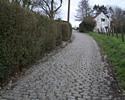
|
Climb 1 - Molenberg
Length: 463m
Average gradient: 7%
Maximum gradient: 14.2%
Surface: Cobbles
Km from start: 134km
Km from finish:125km
This climb can take the uninitiated by surprise. The course is rolling along quite comfortably along a nice, flat, well surfaced road when it suddenly takes a sharp right turn and is faced with a steep wall of cobbles. First time riders may find themselves almost grinding to a halt as they're stuck in too big a gear, simply because they weren't expecting it. The steepest section is near the middle before it begins to ease off and the cobbles give way to asphalt for the last few metres.
Despite being pretty steep, and the race's first exposure to uphill cobbles, there's not too much to trouble anyone here. Legs will be pretty fresh for all but the domestiques who've been doing all the work up to this point. The favourites will want to be near the front, because the climb is narrow and they won't want to be delayed behind any slower riders, but it's unlikely that any of them will show their hand at all this early on.
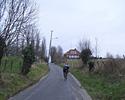
|
Climb 2 - Wolvenberg
Length: 645m
Average gradient: 7.9%
Maximum gradient: 17.3%
Surface: Asphalt
Km from start: 144km
Km from finish:115km
Turning off the long Kerkgate sector of cobbles, the course drops abruptly down to the village of Volkegem where it turns right to the bottom of the Wolvenberg. There's no gentle introduction to this one, it just rears up in front of you almost before you're ready for it and doesn't let up until you're nearly at the top where it eases off.
As before, it's still far too early for a serious move from any of the favourites, but they will all be near the front and may well put in a bit of a dig just to see how the others react. The steepness will spell the end for some of the lesser riders and anyone who's been working too hard.

|
Climb 3 - Kluisberg
Length: 925m
Average gradient: 6.8%
Maximum gradient: 14.5%
Surface: Asphalt
Km from start: 165km
Km from finish: 94km
This climb returns for the first time since 2003. Its exclusion may have something to do with the fact that the only way to go once you reach the top is down the other side, and that is into Wallonia - and this is the Ronde van Vlaanderen! In fact as soon as the road crests the top the name changes to the Mont de l'Enclus and suddenly the road signs are all in French.
The road rises gently until it rounds the last corner and steepens considerably, this gradient is maintained all the way to the top where it levels off abruptly.
With 94 km to go it's too early to be decisive, but coming as it does after a long flat section - probably with head or crosswinds - this will hurt the legs of those who've been working hard. The presence of several restaurants, cafes and bars at the top means that there will always be a higher than average quotient of rabidly drunken Flemish fans on this one!
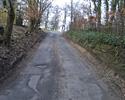
|
Climb 4 - Knokteberg
Length: 1260m
Average gradient: 7.3%
Maximum gradient: 13.3%
Surface: Asphalt
Km from start: 173km
Km from finish: 86km
This climb comes with the Kluisberg as a pair, by virtue of the fact that it's the quickest way of getting out of Wallonia and back into Flanders. In truth it should be called the Côte de Trieu, in French (as it is in Het Volk) because it's a Walloon climb, but this is the Ronde van Vlaanderen and they don't use that language.
The climb snakes gently upwards through some fields without ever getting particularly steep, then ramps up as it nears the top and crosses the border back into Flanders.
Nothing here to trouble the favourites and the big boys should continue to sit in and wait.
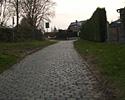
|
Climb 5 - Oude Kwaremont
Length: 2200m
Average gradient: 4%
Maximum gradient: 11.6%
Surface: Cobbles
Km from start: 180km
Km from finish: 79km
Since they surfaced the main road, Nieuw Kwaremont, this climb has become a fixture in the Ronde. It's one of the most colourful parts of the race from a fans perspective, there are always thousands of fans lining the route as this, for many, is where the real race starts. There are always caricatures of the local favourites, and heroes of the past dotted up the side of the road.
It twists gently out of Kluisberg before turning to cobbles and steepening, the road levels out considerably as it passes through the village of Kwaremont, before rising up again on the way out.
With a maximum gradient of 11.6%, it's not going to put too many riders in trouble, apart from those who are already getting tired, but the mere fact that it has 1600m of uphill cobbles really makes this one felt. Generally, this is the point where one of the stronger teams starts to gently turn the screw by putting a few men on the front and increasing the pace a notch. This is to jettison as many of the weaker riders as possible, but also to get their man into a good position for the next climb where things start to get serious.
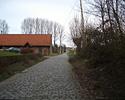
|
Climb 6 - Paterberg
Length: 360m
Average gradient: 12.9%
Maximum gradient: 20.3%
Surface: Cobbles
Km from start: 183km
Km from finish: 76km
With the absence of the Koppenberg, this is the steepest climb in this year's Ronde.
This one is a real monster. The riders turn a sharp right-hander at the bottom and it just rears up in front of them. With a maximum gradient of over 20% it gets steeper and steeper, not letting up until the top - and it's cobbled all the way up. The only saving grace is that it's mercifully short, and also, due to it's exposed position it dries pretty quickly, so if it's showery then it doesn't stay too slippery for long.
This is a real fans' favourite - hundreds (even thousands) of people try to squeeze into the small areas at the sides and top - it's got so crowded that the organisers have had to put high fences up, not to stop the riders going off course, but to prevent the fans from spilling on to the narrow cobbled surface.
With 76km still to go, it's still a bit early for a race-winning move, but its ferocity is usually too much for some to resist. Expect to see a dig from one of the favourites - probably the one whose team was putting the pressure on at Oude Kwaremont. This may have the effect of pulling a smallish group clear, as Boonen's attack on the Koppenberg did last year. Any favourites missing this split will have to get their team to do an awful lot of work to get them back, and they may well find that they've missed the boat.
The road is very narrow for a peloton that may well still be up to 150 strong, so expect to see the ones at the back having to walk - if it's wet, then it will be chaos!

|
Climb 7 - Kortekeer
Length: 1000m
Average gradient: 6.4%
Maximum gradient: 17.1%
Surface: Asphalt
Km from start: 188km
Km from finish: 71km
In the absence of the Koppenberg (they generally use one or the other as they're not very far apart) this is the climb to use to get the race back in the direction it wants to go in. Similar in many ways to the Knokteberg, it starts of gently enough before steadily getting tougher and tougher as it winds its way through the woods. The asphalt is fairly smooth, but is usually covered in mud and gravel from the high banks on either side. If it's wet it could be fairly slippery.
If a break got away on the Paterberg then they should work together on this one in order to hold off any of the favourites they managed to lose. If not then another dig by one of the favourites - or a team mate - may well happen in order to reapply the pressure on anyone not on top of their form.
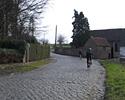
|
Climb 8 - Steenbeekdries
Length: 700m
Average gradient: 5.3%
Maximum gradient: 6.7%
Surface: Cobbles
Km from start: 192km
Km from finish: 67km
The only difficulties facing riders on this climb is the fact that it is cobbled and comes at the end of a flat stretch of cobbles that will give stronger teams the opportunity to put the hurt on those riders who aren't so proficient at riding them. What's more frightening is the descent down the other side, a straight cobbled road that's steeper than the one they just climbed up - so much so that, if the direction of the course didn't dictate it, you'd expect them to be racing up this side (in fact, when this climb was first introduced in 2002, fans of Nico Mattan painted his name on the downward side - assuming that the course would climb up that way).
If conditions are wet then this descent is potentially pretty dangerous, but even in the dry it will be shaking water bottles loose all over the place, so great care is needed. To add a bit of extra spice, the road turns sharply at the bottom of the still cobbled road so that it can cross a railway line.
Due to the potentially treacherous nature of the descent, staying out of trouble is key here for the front runners. If they're already in a smallish breakaway group they'll feel more comfortable because they will be less likely to encounter issues with other people's bottles - or crashes.

|
Climb 9 - Taaienberg
Length: 530m
Average gradient: 6.6%
Maximum gradient: 15.8%
Surface: Cobbles
Km from start: 194km
Km from finish: 65km
This is a pretty little climb that rises through a wooded area, but is also a real leg sapper. It is cobbled all the way to the top, but there is a smooth gutter up the right hand side which riders often ride up in the places where it's free of mud. The steepest section is in the middle, but the cobbled surface prevents it from ever becoming particularly comfortable.
This climb usually has the effect of weakening and slowing down any early attackers who have managed to stay away until now. Everyone else will be doing their best to stay out of trouble and get up the steep cobbles with as little effort as possible.
Click here for the second page, featuring the final nine climbs and a full list of photos.
